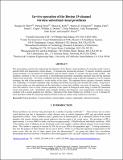| dc.contributor.author | Wyatt, John L. | |
| dc.contributor.author | Mendoza, Oscar D. | |
| dc.contributor.author | Kelly, Shawn K. | |
| dc.contributor.author | Doyle, Patrick S. | |
| dc.contributor.author | Shire, Douglas B. | |
| dc.contributor.author | Gingerich, Marcus D. | |
| dc.contributor.author | Chen, Jinghua | |
| dc.contributor.author | Cogan, Stuart F. | |
| dc.contributor.author | Drohan, William A. | |
| dc.contributor.author | Theogarajan, Luke | |
| dc.contributor.author | Rizzo, Joseph F. | |
| dc.date.accessioned | 2010-09-16T15:38:38Z | |
| dc.date.available | 2010-09-16T15:38:38Z | |
| dc.date.issued | 2010-02 | |
| dc.date.submitted | 2010-01 | |
| dc.identifier.issn | 0277-786X | |
| dc.identifier.other | Proc. SPIE, Vol. 7527, 752705 (2010) | |
| dc.identifier.other | SPIE-IS&T/ Vol. 7527 752705-8 | |
| dc.identifier.uri | http://hdl.handle.net/1721.1/58563 | |
| dc.description.abstract | This presentation concerns the engineering development of the Boston visual prosthesis for restoring useful vision to patients blind with degenerative retinal disease. A miniaturized, hermetically-encased, 15-channel wirelessly-operated retinal prosthetic was developed for implantation and pre-clinical studies in Yucatan mini-pig animal models. The prosthesis conforms to the eye and drives a microfabricated polyimide stimulating electrode array having sputtered iridium oxide electrodes. This array is implanted into the subretinal space using a specially-designed ab externo surgical technique; the bulk of the prosthesis is on the surface of the sclera. The implanted device includes a hermetic titanium case containing a 15-channel stimulator chip; secondary power/data receiving coils surround the cornea. Long-term in vitro pulse testing was also performed on the electrodes to ensure their stability over years of operation. Assemblies were first tested in vitro to verify wireless operation of the system in biological saline using a custom RF transmitter circuit and primary coils. Stimulation pulse strength, duration and frequency were programmed wirelessly using a computer with a custom graphical user interface. Operation of the retinal implant was verified in vivo in 3 minipigs for more than three months by measuring stimulus artifacts on the eye surface using contact lens electrodes. | en_US |
| dc.language.iso | en_US | |
| dc.publisher | SPIE | en_US |
| dc.relation.isversionof | http://dx.doi.org/10.1117/12.846745 | en_US |
| dc.rights | Article is made available in accordance with the publisher's policy and may be subject to US copyright law. Please refer to the publisher's site for terms of use. | en_US |
| dc.source | SPIE | en_US |
| dc.title | In vivo operation of the Boston 15-channel wireless subretinal visual prosthesis | en_US |
| dc.type | Article | en_US |
| dc.identifier.citation | Shire, Douglas B. et al. “In vivo operation of the Boston 15-channel wireless subretinal visual prosthesis.” Human Vision and Electronic Imaging XV. Ed. Bernice E. Rogowitz & Thrasyvoulos N. Pappas. San Jose, California, USA: SPIE, 2010. 752705-8. ©2010 SPIE. | en_US |
| dc.contributor.department | Massachusetts Institute of Technology. Department of Electrical Engineering and Computer Science | en_US |
| dc.contributor.department | Massachusetts Institute of Technology. Research Laboratory of Electronics | en_US |
| dc.contributor.approver | Wyatt, John L. | |
| dc.contributor.mitauthor | Wyatt, John L. | |
| dc.contributor.mitauthor | Mendoza, Oscar D. | |
| dc.contributor.mitauthor | Kelly, Shawn K. | |
| dc.contributor.mitauthor | Doyle, Patrick S. | |
| dc.contributor.mitauthor | Drohan, William A. | |
| dc.relation.journal | Proceedings of SPIE--the International Society for Optical Engineering | en_US |
| dc.eprint.version | Final published version | en_US |
| dc.type.uri | http://purl.org/eprint/type/JournalArticle | en_US |
| eprint.status | http://purl.org/eprint/status/PeerReviewed | en_US |
| dspace.orderedauthors | Shire, Douglas B.; Doyle, Patrick; Kelly, Shawn K.; Gingerich, Marcus D.; Chen, Jinghua; Cogan, Stuart F.; Drohan, William A.; Mendoza, Oscar; Theogarajan, Luke; Wyatt, John; Rizzo, Joseph F. | en |
| dc.identifier.orcid | https://orcid.org/0000-0003-3533-5268 | |
| dc.identifier.orcid | https://orcid.org/0000-0003-0044-4317 | |
| mit.license | PUBLISHER_POLICY | en_US |
| mit.metadata.status | Complete | |
